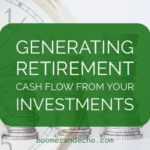Here are some strategies for getting cash flow from your retirement portfolio:
1.) Income only
This option is popular with retirees who want to maintain the value of their assets. Using this strategy, the retiree subsists on whatever income their bond and stock holdings generate.
Pros: As it doesn’t involve tapping into principal, this approach provides some insurance that a retiree won’t outlive assets. Investors tend to be more relaxed with short-term market volatility while receiving regular payouts.
Cons: Days are long gone where you could buy GICs and bonds yielding a safe 10 or 12%. Retirees in the 1990s were dismayed to see the interest on renewals drop from double-digit to mid-single digit rates, and now you may not get much more than 2%.
More investors are leaning towards dividend-paying stocks. A basket of dividend-paying stocks might generate 3% or 4% without taking on too much risk. Given these current low returns, the securities in a portfolio may have trouble generating a livable yield. Depending on your income requirements, you’ll likely need quite a large amount of invested capital to generate the income you desire.
Related: Why Living Off The Dividends No Longer Appeals To Me
Be careful when hunting for yield. Dividends are not guaranteed. Changes to a company’s dividend policy could occasionally result in payouts being reduced or eliminated altogether.
In reality, most investors will need to dip into their principal anyway to meet unexpected large expenses.
2.) Total return strategy
Here, retirees reinvest all income, dividends and capital gains back into their holdings at their target allocation after taking the amount they need for annual living expenses.
Pros: By rebalancing, it forces the investor to sell appreciated assets on a regular basis while leaving underperforming assets in place, or adding to them.
Cons: If there is a prolonged market downturn, withdrawals can drastically erode capital and reduce future return potential. That argues for holding a comfortable cushion of at least 3 –5 years worth of living expenses in liquid form – cash or cash alternatives.
I think this approach works best for investors holding a small number of broadly diversified ETFs, or mutual funds rather than individual stocks and bonds. Holders of individual stocks tend to be too attached to them: “I can’t sell now, look at the money I’m making!” / “I can’t sell now, I need to wait a bit to recoup my losses.”
3.) Annuities
Related: Five Ways To Enhance Your Retirement And Stave Off Crisis
Many annuity types (such a variable annuities) carry high costs which can erode some of the benefits. Each additional feature – survivorship, term guarantee, inflation protection, etc. – will reduce the payment amount.
Final thoughts
Most retirees will use a combination of two or three of these withdrawal strategies to generate retirement cash flow.
It’s important to build an appropriate level of flexibility into your plan so you can manage income needs and expenses, and also be able to choose to time the withdrawal of your capital when market conditions are the most favourable.
 Marie Engen is the “Boomer” half of Boomer & Echo. In addition to being co-author of the website, Marie is a fee-only financial planner based in Kelowna, B.C. This article originally ran at the Boomer & Echo site on March 27, 2018 and is republished here with permission.
Marie Engen is the “Boomer” half of Boomer & Echo. In addition to being co-author of the website, Marie is a fee-only financial planner based in Kelowna, B.C. This article originally ran at the Boomer & Echo site on March 27, 2018 and is republished here with permission.




It is worth being aware that instead of letting payments lapse on an insurance policy that there could very well be redeemable value. So readers should first check for this n if they are cash strapped. Bearing in mind of course other concerns. But it beat just letting a policy lapse and leaving “money on the table”